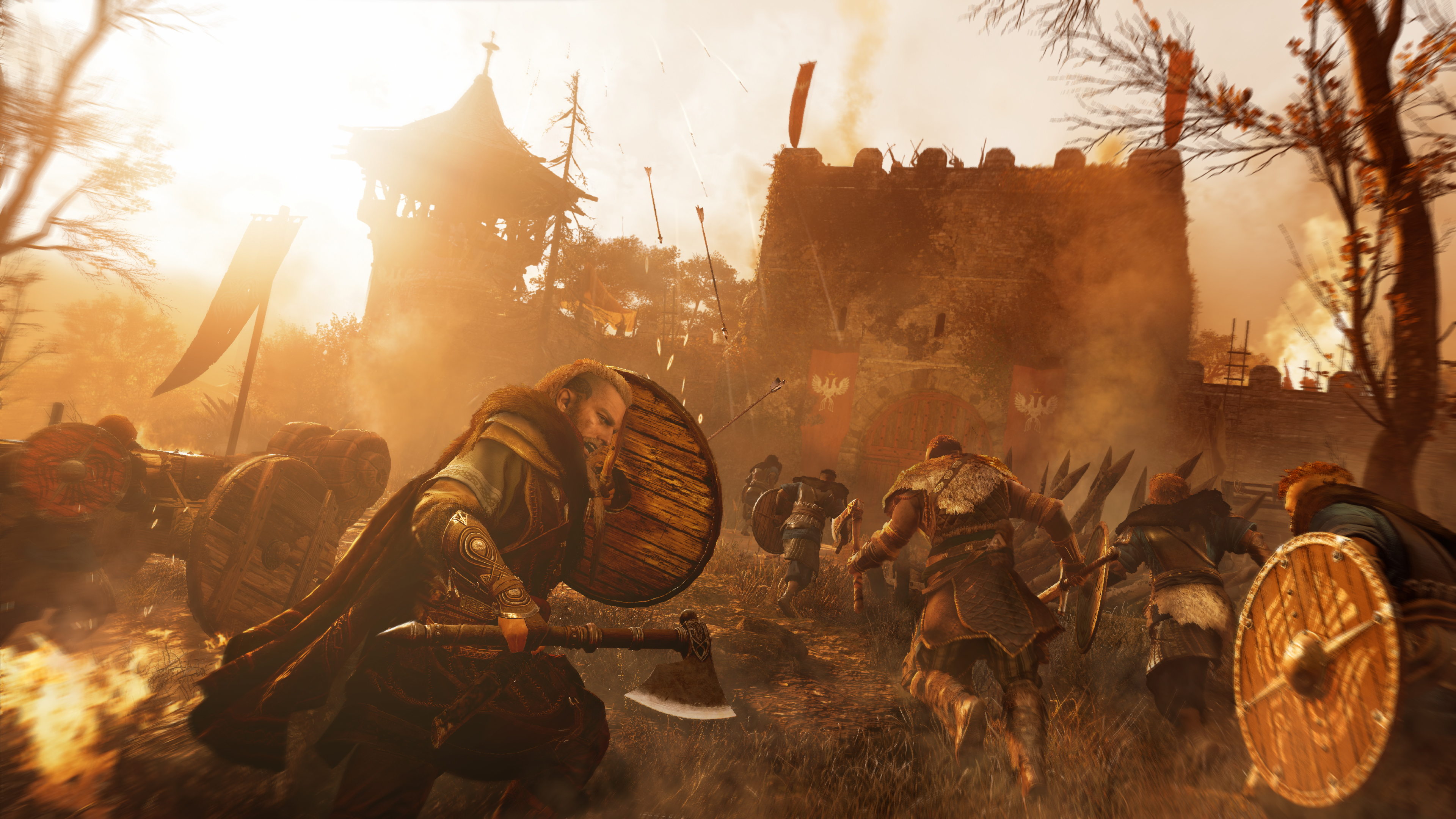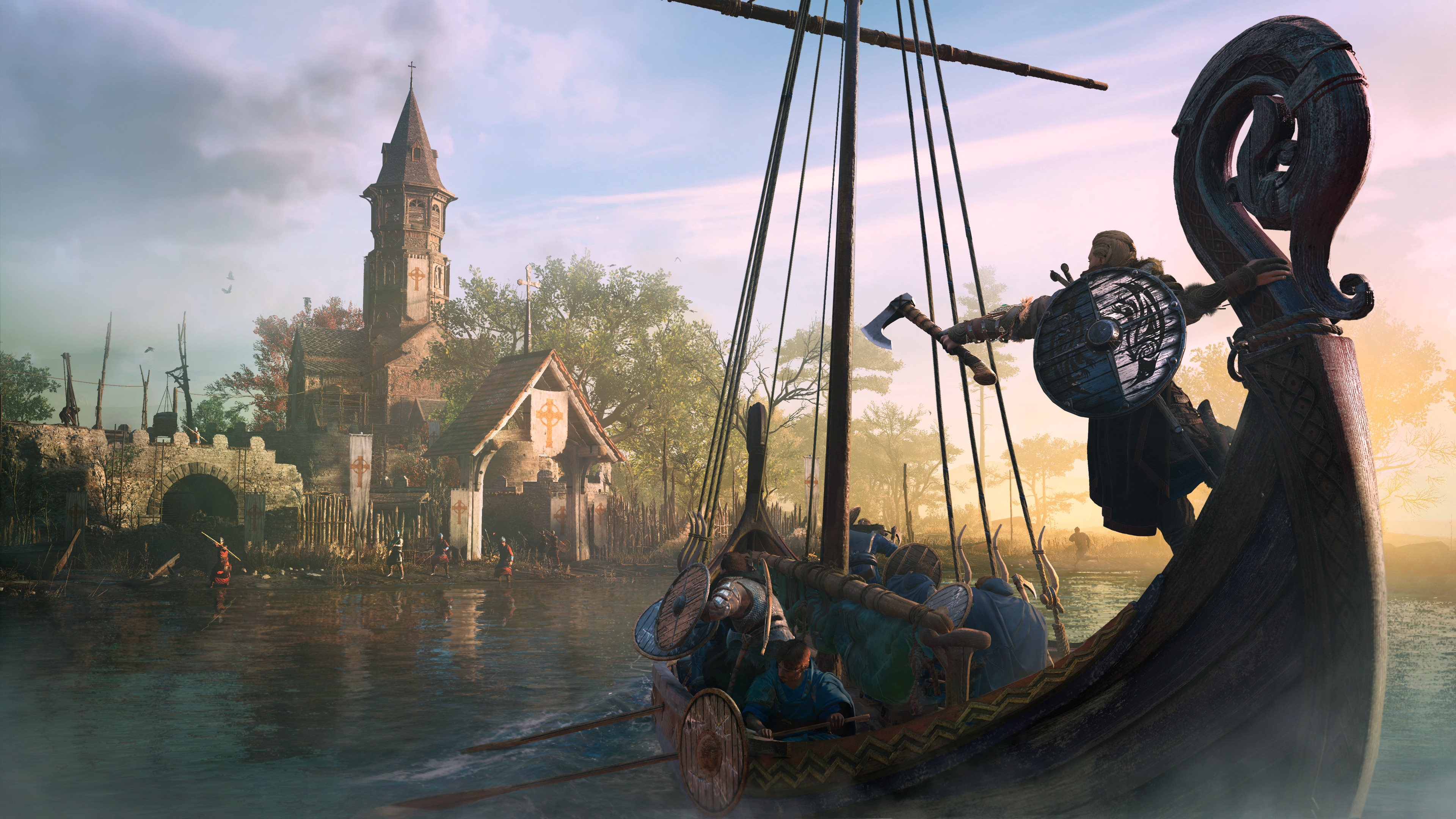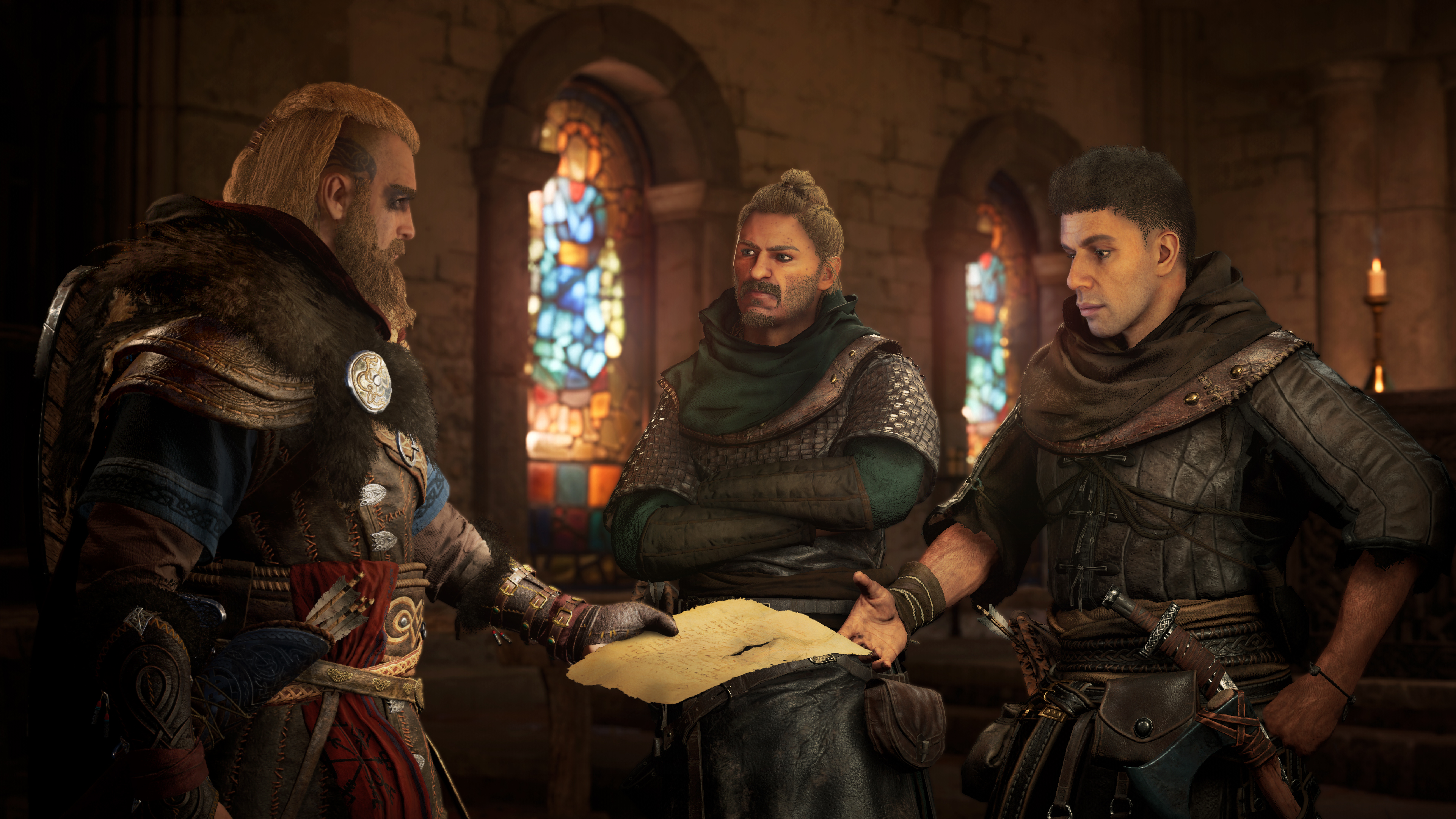One of the quirks of the streamed gameplay session I had with Ubisoft for Assassin's Creed Valhalla wasn't that there was persistent lag, but wildly inconsistent amounts of it. I bring this up because Valhalla felt much more demanding about timing and spacing than either of its two predecessors, Origin and Odyssey. Throughout my entire demo I couldn’t quite figure out whether the combat is genuinely more difficult, or if I just couldn’t come to grips with the lag produced by a problem with my internet connection. Because it sure felt like the series has taken another step away from the button-mashing, rhythm-focused combat of the early games and toward something more akin to fighting games in terms of how it demands players get a feel for weapon distances, animation timings, and timed blocks and parries.
It was a pressing concern because Valhalla is just about the game you’d expect: as the proud, omnicompetent viking warrior Eivor, you’re as likely to try a frontal assault as strike from the shadows. And when Eivor goes raiding with their Viking warband, or takes part in a massive military assault with their allies, there’s nothing to be done but break out the axe and shield and get to work chopping through dozens of deadly foes. Different enemy types present very different threat profiles and demand different approaches, and sorting through all of it in the heat of a chaotic battle is satisfyingly frantic while stopping shy of being overwhelming.
Most of what Eivor had to do in the demo I played had less to do with sneaking around and cutting throats than it did storming castles and brawling in monasteries. The section I played occurred in a war-torn East Anglia, where a Danish warlord had recently deposed a softboi king who was accepted by both Saxons and a lot of the Vikings who now share the land. The vibe was extremely reminiscent of The Witcher 3’s Velen territory: burning villages and bandit camps abounded. The difference is that Eivor has a lot of direct agency is reshaping the politics of their setting. One of the first things I had to do was convince a local village chief to join my quest to reinstate the king. He asked me to go clear out a local church and blow the horn atop it to signal the all-clear ( Valhalla seems like it will miss no opportunity to show your character blasting a deep note from a comically oversized horn). I was able to quietly dispatch most of the guards around the church but inside was a miniboss and two tough allies who took a lot of punishment before going down.

I also had the option, as I sailed around the local waterways, to raid a local monastery. By clicking “start raid”, your oarsmen don their gear and disembark with you as soon as you make landfall, and start tearing through defenders while you search for treasures. It’s a pretty normal brawl, a small taste of Dynasty Warriors inside Valhalla, but succeeds at evoking the typical Viking fantasy of menacing ships full of unconquerable warriors leaving burning buildings and weeping priests in their wake.
There are even larger battles in the main campaign, and they’re a significant upgrade over what we saw in Odyssey. The best sequence I saw involved an amphibious assault against the Danish warlord’s castle in a driving thunderstorm. I steered my longship over the rolling waves to the distant fortress, navigating by the flashes of lightning that threw its tower into relief against the night sky. As we approached it started launching fire arrows I had to dodge before the longships skidded onto the beach and dozens of Viking and Saxon warriors poured through a breach (made, somewhat doubtfully, by crashing a longship into it). The castle’s defenders met the charge in the outer courtyard while a group of Eivor’s men wheeled a ram into place in front of the gatehouse as defenders poured arrows and burning oil down atop them. I could speed up the process of shattering the gate by joining in their work of charging it with the ram, or I could help cut the numbers of the fort’s defenders by engaging in the melee that surrounded me. I was also able to disable the archers on the walls by shooting their oil pots and setting their entire battlement ablaze.
The outer gate yielded to an inner courtyard where tougher enemies awaited. Aggressive, fast-attacking berserkers swarmed me, which created lots of openings for heavy axemen to land some devastating blows, and I burned through a lot of my fast-healing “rations” as I tried to stay on my feet. The only thing helping me keep the fight under control was my special axe throwing ability, where Eivor uses a throwing axe on every enemy in range to deal moderate damage across the board and leave a few enemies stunned and ready for a “stomp” execution, where Eivor marches over and pulverizes their face with a shield.

Finally I made it to the walls of the keep, where I died repeatedly until the person observing the demo noted that the enemies will keep spawning forever until I killed the boss hiding inside. So I ignored the fight, scaled the walls, and got into a brutal boss battle with the boss and his pet wolf. It involved a lot of dodging, special attacks, and arrow spam—not exactly memorable stuff even if the snarled dialogue between the combatants and the doomsday atmosphere around this showdown was terrific.
It seems like, as with Odyssey, some of the really interesting boss fights are optional challenges in the open world, where attack patterns are significantly more varied and the enemies have far more special abilities. At one point I found a haunted arena guarded by a mysterious Valkyrie who could attack you with phantoms and warp short distances.
It was a cool fight, but brutally difficult during the streamed gameplay session I had with Ubisoft last week. A concession to the cancellation of E3 and the United States’ ongoing failure to manage the COVID-19 pandemic, Ubi gave journalists and influences extended hands-on demo sessions with Valhalla last week using the Parsec service. It was impressively stable throughout my demos but prone to sharp input lag spikes (or just outright failures to register button presses) and sudden blizzards of artifacting. I can’t really blame Parsec or Ubisoft, to be clear: these issues were the first sign of an internet issue in my building that escalated into a full outage two days later. If anything, I’m actually more amazed that the connected stayed up despite near-complete internet drops.

Valhalla marks a departure of another sort for the Assassin's Creed series, as its creative director and a member of the series’ design leadership for several years just resigned from his position in one of the many allegations of scandal or misconduct at the company. While it seems likely the ramifications around the allegedly abusive and unaccountable culture at Ubisoft’s Canadian studios will continue to widen (at the end of last week, Ubisoft’s chief creative officer resigned from the company, as well as the head of the company’s Canadian studios), Valhalla is indelibly connected with these events. No interviews were offered for the event, which was solely focused on the game demos and no development staff were made available for questions, but long-term that strategy seems unlikely to work. Ubisoft games have been so carefully mass-produced to a narrow set of specifications that it was easy to imagine the production behind them as highly professionalized and carefully maintained. That image has been destroyed by the events of recent weeks, and it’s harder to play these games and not wonder about the perspectives that guided and shaped the experience.
For example, after wrapping up the main quest line available in the demo and restoring the Saxon Thegn Oswalt to rule East Anglia and alongside his new queen, Valdis, the new couple throws a huge wedding party. It is a drunken revel outside a small church, where you can get in a drinking game with your comrade Broder. It’s a rhythm-based challenge where you slam ale while a crowd chants “SKOL SKOL SKOL” and you have to time the button presses to the accelerating-chant. Win or lose, your character is a bit drunk with the usual blurred vision and slightly-drifting controls that connote video game drunkenness. You can go play some other minigames (I won a sharpshooting context with a character who wondered if I wasn’t too drunk to pull off his challenge) and talk to an even more-drunk, slightly depressed friend who had to sacrifice his own ship to win this victory, and wonders what is left for him now. Then you find Broder again, who talks about how much he admires Eivor and propositions them (I was playing as a woman, but it didn’t seem like the dialogue was gendered). So Eivor and Broder can sneak off from the party and for some drunken sex. There’s a brief cut, and then we see the pair patting down their clothes and remarking on how amazing it was before resuming the party.
Conventional stuff for a light-hearted sequence in a video game about vikings and Saxons, but then you remember the story from last week about how the often-underpaid and overworked staff at Ubisoft’s studios were given rowdy parties with tons of free booze to boost morale while drunkenness was alleged to excuse all manner of personal infractions and the line between genre convention and implied worldview suddenly seems as blurry as Eivor’s vision. Valhalla may be escapist fantasy for players, but for Ubisoft, context is suddenly inescapable no matter how much they try to keep the focus on their games. Even their most reliably anodyne productions are suddenly freighted with new meanings that the company’s generally shallow politics and historical depictions will struggle to transcend.
from VICE https://ift.tt/2WcuCSM
via cheap web hosting
No comments:
Post a Comment